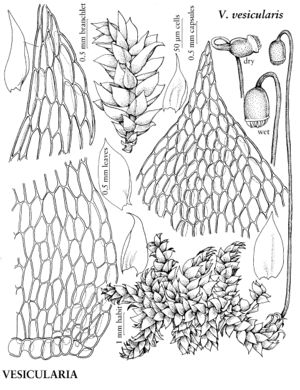Vesicularia
Bot. Jahrb. Syst. 23: 330. 1896.
| Taxon | Illustrator ⠉ | |
|---|---|---|
 | Vesicularia vesicularis | Patricia M. Eckel |
Plants small to medium-sized, in thin to dense mats, usually pale green to yellowish, sometimes dark green, often shiny. Stems creeping, freely branched, irregularly branched to pinnate; hyalodermis absent, central strand present or absent; pseudoparaphyllia linear to foliose. Leaves dimorphic; ventral usually smaller than dorsal, ± appressed, lanceolate to usually acuminate; dorsal leaves spreading to secund, oblong-ovate to ovatelanceolate, somewhat asymmetric; base weakly decurrent; margins plane, entire or serrulate toward apex; apex acute or short to long-acuminate, sometimes apiculate; costa double and short or ecostate; alar cells not or slightly differentiated; laminal cells smooth, walls thin; medial cells at least of lateral leaves relatively short. Specialized asexual reproduction absent. Sexual condition autoicous; perichaetial leaves erect, ovoid, oblong-ovoid, or oblong-ovate, apex subulate. Seta reddish, reddish orange, or yellow-orange. Capsule horizontal to pendent, ovoid to oblong-ovoid, ± asymmetric, constricted below mouth when dry; annulus differentiated; operculum apiculate to short-rostrate; peristome double; exostome teeth with external surface cross-striolate, papillose distally; endostome basal membrane high, segments keeled, cilia usually in groups of 1–3. Calyptra naked. Spores spheric, finely papillose to nearly smooth.
Distribution
se United States, Mexico, West Indies, Central America (Guatemala), n South America, Asia (India), Asia (Japan), Africa, Indian Ocean Islands (Madagascar), Pacific Islands (Philippines), Australia
Discussion
Species 175–190 (1 in the flora).
Vesicularia is a poorly studied genus, and many of its species will undoubtedly be synonymous with other taxa when the group is studied on a worldwide basis.
Selected References
None.